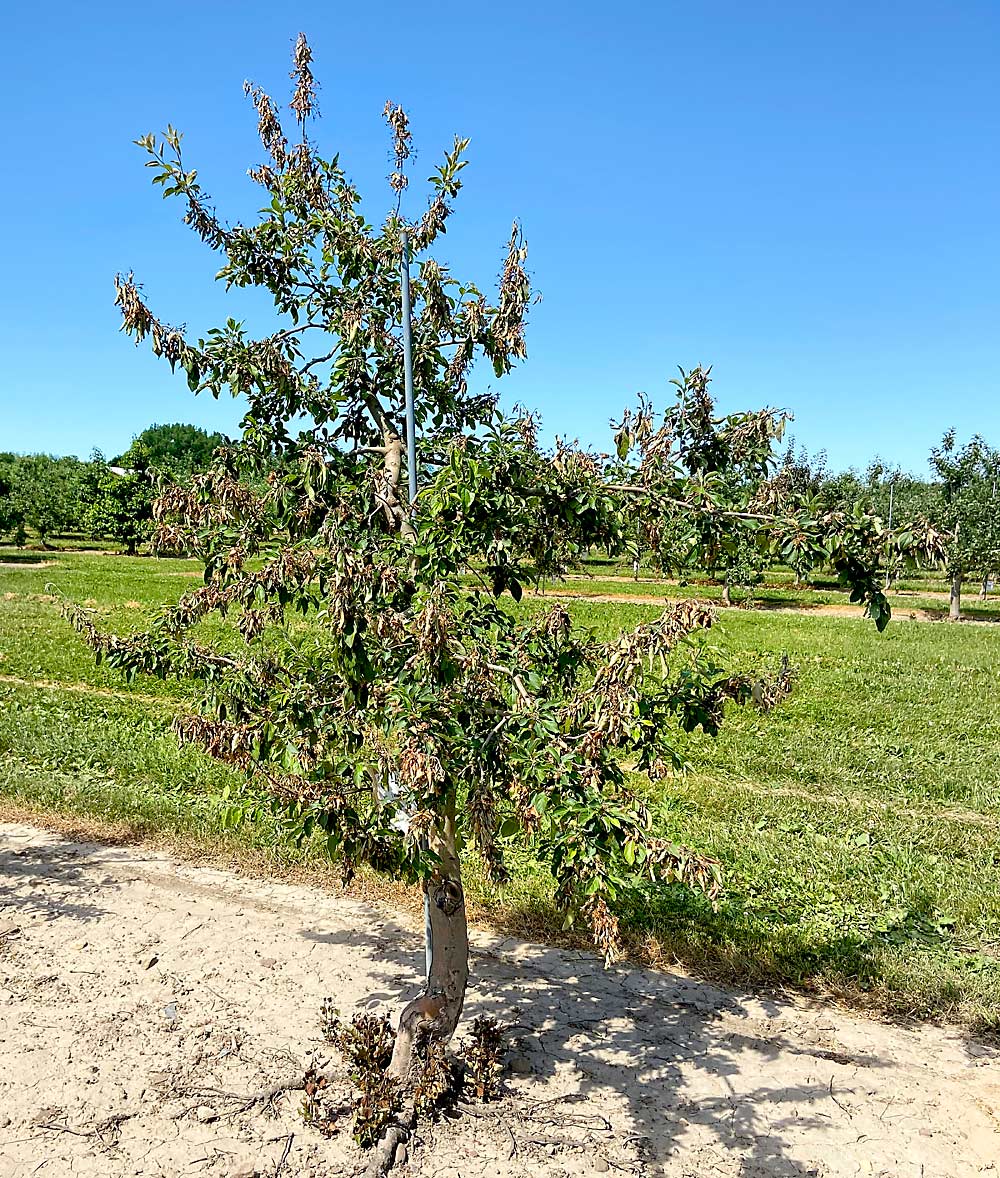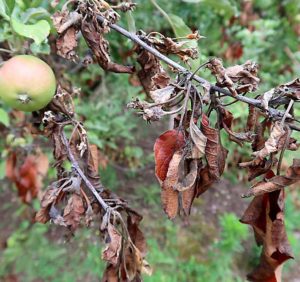
Fire blight has worsened in New York’s apple-growing regions. Whether it’s in the Hudson Valley, Champlain Valley or Western New York, the realization has hit home for the state’s growers within the past decade, and they know they have to be more vigilant than they used to be.
That was the takeaway from a panel discussing fire blight during Cornell University’s New York State Tree Fruit Conference, a virtual event held in late January. Panelists gave multiple reasons for the worsening fire blight problem, including higher temperatures and humidity in spring, more susceptible varieties and a longer bloom period.
“Back in my early days, bloom usually was a 10-day event,” said Jim Eve, who’s been a fruit consultant in Western New York and the Champlain Valley since 1962. “Now it goes on for what seems like a month.”
According to panelists, containing fire blight outbreaks mostly comes down to intensive spray programs, applied consistently from year to year.
Some growers tend to take the foot off the pedal when the pathogen seems under control, consultant Andy Vega said.
“Sometimes we relax a bit with management tactics when we haven’t seen the pathogen in a few years,” Vega said. “Those putting in new acreage, especially high-density acreage with a lot of investment, tend to be more aggressive in their tactics.”
When Vega first became a consultant in the Northeast, fire blight was considered a “pretty easy pathogen to deal with,” he said. But in 2012, not long after he started, there was a widespread outbreak in the Hudson Valley that opened his eyes to the seriousness of the problem.
Eve said the “wake-up year” for the Champlain Valley was 2016.
In years prior, Champlain Valley grower Jesse Mulbury had found little to no fire blight in his orchards, but in 2016 he found a “shocking” amount in some of his blocks. He and his crews decided to tackle the pathogen “the usual way,” which included cutting out infected wood and sanitizing tools between cuts. But when they returned a couple of days later, they had a “real nightmare” on their hands, he said. Fire blight had spread from the hot spots and was breaking out everywhere.
Mulbury’s team contained the outbreak with intensified sprays, then cut out the infected wood and burned it. They managed to salvage most of their trees, though some looked like “toothpicks,” and it took a couple of seasons for the orchards to fully recover, he said.
Since 2016, Mulbury relies more on a program of streptomycin, copper and biopesticide sprays. He uses models from Cornell’s Network for Environment and Weather Applications and RIMpro to track favorable fire blight conditions. He also informs his spray decisions with thorough scouting and his knowledge of his own orchards, he said.
Fire blight hit Western New York growers hard in 2020. Rich Breslawski said he got his “butt kicked” after years of clean orchards.
Grower Mark Russell spent the same summer “throwing everything in the shed” at his infected orchards, after his typical spring program of streptomycin followed by kasugamycin and then more streptomycin sprays failed to contain an outbreak. At the first sign of infected shoots in 2021, Russell “dropped the hammer” with a strong rate of Apogee (prohexadione calcium), which kept the spread under control in the sprayed areas. He and his crews have gone back to sanitizing tools with alcohol-based sanitizer. They have plenty on hand, thanks to their COVID-19 safety program, he said.
To avoid a repeat of 2020, Breslawski applies two Nu-Cop HB (cupric hydroxide) copper sprays at 1 pound per acre at bud break. Low-dose copper products don’t kill bacteria as quickly as he would like. He rotates streptomycin and Kasumin (kasugamycin) throughout bloom, he said.
Eve, the consultant, recommended applications of streptomycin, Kasumin and copper to combat fire blight. More intensive management is costly, he said, but not as costly as a fire blight outbreak.
Vega encouraged the use of predictive models such as RIMpro, Maryblyt, CougarBlight and NEWA to track fire blight conditions, but he said growers should supplement those tools with specific knowledge of their orchards and microclimates.
In periods of warm weather and high humidity during flowering, which have become more frequent in the past seven years, growers should provide cover sprays every 48 hours, said Virginia Tech (and former Cornell) pathologist Srdjan Acimovic.
Acimovic said growers probably make the most mistakes during petal fall. They think bloom is over, but shoots are growing intensively, and some flowers are still open. Both can be infected by fire blight inoculum.
Penn State University pathologist Kari Peter said Actigard (acibenzolar-S-methyl) is a must for “disaster scenarios,” and it needs to be applied 48 hours before the infection period.
Fire blight has always been unpredictable, and that unpredictability demands constant vigilance. But sometimes even vigilance isn’t enough, said Cornell plant pathologist Kerik Cox.
“Any time we think we’ve got fire blight figured out, it’ll throw a wrench,” he said.
—by Matt Milkovich








Leave A Comment